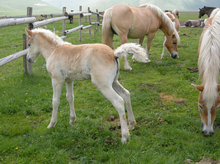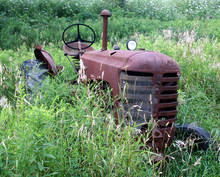The beginning of summer is a great time for horse owners with pastures to begin planning and implementing proven techniques that will provide grazing throughout most of the year, suppress weeds, and make pastures pleasing both to themselves and non-horse keeping neighbors.
Anyone who manages a horse on a property knows that it is a labor of love and not an inexpensive one. Horse owners often say that their highest costs are feed bills, and with so many feed, supplement and hay choices it can be tricky to know just what your horse needs.
The best place to start is to ensure you have a well-maintained pasture with healthy grasses which can be a nutritious and relatively inexpensive feed source for horses. However, pastures can quickly degrade and the horse owner ends up spending more money on feed and supplements.

Minimizing feed bills and improving horse health
Horse owners often say that their highest costs are feed bills, and with so many feed, supplement and hay choices it can be tricky to know just what your horse needs.
Grazing your horses on degraded pasture can also lead to colic, greasy heel, parasites and poisoning from weeds. One of the best ways to care for your horse is to care for your land so it can provide healthy pastures all year round.
According to Penn State Extension Services, high-quality, properly fenced pastures are one of the best and least expensive sources of summer feed for a horse. A well-kept pasture also is the most natural and healthy environment for exercise and rest.
1. Soil Testing, Fertilizing and Liming
If your pastures have not been tested for nutrient levels within the last 2-3 years, now is a good time to do it. Obtain sample boxes and a soil sample information sheet from your local library or a local extension service that will perform an analysis, send you the results, and recommend quantities of fertilizer and lime needed to produce maximum pasture yield.
Follow the recommendations for fertilizer application and repeat yearly. While fertilization can be done at any time of the year, you will realize maximum benefit if you fertilize cool season grasses in the fall. This is when most weeds die back, and grasses are dormant in their above- ground growth.
During this period, applied nutrients help root systems develop into more mature organs, capable of penetrating deep into the soil. A well-developed root system can extract water from greater depths, especially during the summer drought spells.
In early spring, you can boost the leafy growth of your pastures by adding 50 pounds of nitrogen per acre, as long as your pasture does not consist of legumes, such as clovers.

Importance of soil testing, fertilizing and liming
If your horse pasture has not been tested for nutrient levels within the last 2-3 years, now is a good time to do it.
Applying the correct amount of fertilizer does not guarantee a healthy pasture if the pH level is too low. In low pH (acidic) conditions, plant nutrients are chemically bound and unavailable for absorption by cool season grass roots.
A soil pH of 6.2 is the ideal condition in which pasture grasses can readily absorb their much-needed nutrients. A higher pH level than 6.2 does not improve pasture yield.
Unlike fertilizers, agricultural lime does not readily dissolve to become a part of the soil chemistry. Therefore, if the recommended lime application is greater than 2 tons/acre, you can avoid waste by splitting the applications 6 to 9 months apart unless you can disk the whole amount into the soil. This is possible if you are establishing a new pasture or replanting a deteriorated field back into pasture.
Lime applications are equally effective at any time of the time of the year. However, no more than the total recommended amount should be applied over a three year period. After three years, the soil will need to be retested.
2. Over-seeding and renovating bare spots in the horse pasture
Over-seeding replenishes the stand of grass within an existing pasture area. For pastures with cool season grass mix, it is best to over-seed during the late summer or early fall. To ensure good seed-soil contact, use a drill seeder.
If you don't have a drill seeder, hand-broadcast the seeds or use a seed spreader, and then spread a thin layer of composted manure one-half to one-quarter inch over the seeded area to create improved seed-soil contact.
Usually over-seeding requires minimal soil preparation, unless the process is combined with pasture renovation. Pasture renovation includes filling depressions and eroding areas with topsoil (not composted material), and then seeding.
Pasture renovation commonly includes restoring grass cover in high traffic areas, such as along fences and around gates. Use temporary fencing to keep the horses out of the area during renovation until the new grass is well established. The area must be disked, graded and reseeded. Consider hardy grass species, such as tall fescue, when reseeding high traffic areas.

Renovating bare spots in the horse pasture
Pasture renovation commonly includes restoring grass cover in high traffic areas, such as along fences and around gates.
Reestablishing a pasture area that has turned into a dirt or weed field is also considered pasture renovation, but more extensive soil preparation is necessary; fertilizing, liming and seeding are the very least to be done.
It is essential to keep the soil moist by watering and mulching with straw to keep the germinating seeds from dehydrating and dying.
Do not allow horses to graze the field for one full year after you have achieved growth in the renovated pasture area. Otherwise, your labor will be for naught.
During the wait, consider cutting the grass for hay. If you cannot keep the field unused for an entire year, then renovate the area in sections, a year at a time.
3. Establishing and maintaining a sacrifice area
Sacrifice areas are key to successful pasture management, especially in situations where horses are kept in relatively small acreage. For one or two horses, a sacrifice area can be as little as a 350 sq. ft. (14" X 25" fenced in area.
The cost of pasture as a feed is estimated to be about one-tenth the cost of hay.
Horses can be kept within the sacrifice area and provided with hay and drinking water. Here, they can "horse around" and get their much-needed exercise with no harm to your pastures.
Sacrifice areas provide respite for pastures exposed to intense grazing. Intensely used pastures are impossible to manage without the incorporation of a sacrifice area into the rotational system.
Extreme weather conditions such as drought and excessive rain also create conditions that demand the use of a sacrifice area.
In a newly established pasture, keep the horses in the sacrifice area until after a year of growth. After a year, allow up to 50% of the available grass to be grazed. Then give the field a chance to recover, until re-growth is about six inches high. Depending on the weather and soil conditions, the re-growth period may be one to three months.
Conditions necessary for a successful sacrifice area include:
- Proper drainage
- Maintain a surface slope of about 3% to prevent erosion.
- Establish good drainage at the time of construction or renovation. A standard design includes spreading a sheet of heavy duty geotextile in contact with the graded soil surface and a six-inch layer of crushed limestone rock consisting of particles sized at 3/4 inch to 3 inches median diameter on top of the geotextile. The layer of crushed limestone is then capped with 3 to 4 inches of fine cover material which can be ground lime stone, crusher run or mulch. Limestone has proved to be the best capping material.
- Divert all offsite flows such as barn runoff around the area.
- Waste removal
- Remove waste from the site on a daily basis or before rain.
4. Controlling your horse's grazing pattern
Once the pasture is established and rapidly growing, the next step is to control when, where, and for how long the animals graze. Achieve this easily by installing cross fences to separate the grazing area into smaller fields.
By nature, horses tend to like to forage in long straight lines. Therefore, consider dividing your pasture into longer fields, rather than the traditional square fields. Always keep in mind that fields can be divided using temporary fences.
Did you know?
Horses digest highly mature, stemmy forage poorly. Energy digestibility coefficients for forages decrease from more than 50 percent to less than 30 percent as quality of forages decreases.
Controlling the grazing pattern through shorter grazing periods and rotating the horses through the pastures will help the grass stay resilient and prevent weed growth. Controlling grazing intensity and timing through a rotational system can also provide a longer grazing season. This also provides an even distribution of manure throughout the fields, controls the possibility for horses to over-graze, and reduces erosion.
Fields should be rested as soon as the pasture has been grazed down to about 2 to 3 inches high. An unevenly grazed pasture should be mowed to make for uniform re-growth. Dragging horse droppings on a regular basis helps prevent clusters of non-grazed vegetation within a field.
Many horse owners don't realize that a grazing horse cannot see what it eats due to a blind spot immediately in front of its head. Pasture selection is based on smell, touch and taste. Smell is the most important and is critical in determining the palatability (acceptance) of pasture. The smell and avoidance of pasture soiled by manure causes "horse-sick" pastures.
It is also important to keep horses and other animals out of water saturated pastures to prevent both damage to the pasture and erosion.
5. Controlling weeds in horse pastures

An overgrown weedy pasture
Weed control techniques include regular mowing of weeds especially before they get to seed production stage.
Control weeds with a combination of techniques. Proper identification of weeds is key to determining the most effective herbicide, and the best time in their life cycle to be treated.
Adequate, but not excessive fertilization and liming, and a controlled grazing practice create conditions for preferred vegetation to thrive over unwanted weeds.
Other great weed control techniques include:
- Regular mowing of weeds especially before they get to seed production stage.
- Composting of horse manure to kill contained weed seeds.
- Using high quality seed mix that contains a low percentage of weed seeds.
Pastures can be a rich source of nutrients for your horse. As most horse owners know, quality forage, whether it is hay or pasture, should be the foundation of any horse's feeding program. Good quality pasture can provide much of the nutrition a horse needs.
Now you know!
Another important fact about pastures is that they also provide an economical source of forage. The cost of pasture as a feed is estimated to be about one-tenth the cost of hay.
